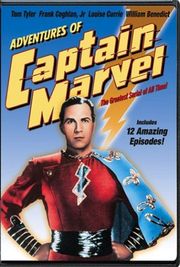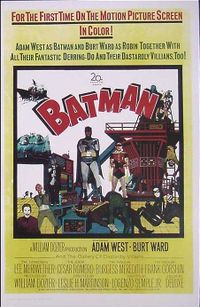For task 12, i will be researching on historical texts which will be relevant for my independent study. Below are a sequence of texts which will be used to look at, research on them and apply them to the essay. 
1. Adventures of Captain Marvel (William Witney and John English, 1941)
Synopsis:
The serial featured an adaptation of the Fawcett Comics superhero in an original story where he fought a criminal mastermind, called The Scorpion, who is determined to gain total control of a magic gold scorpion figurine of incredible power (including, but not limited to, melting rock via a death ray).
The Golden Scorpion is found in a expedition to Siam during which young Billy Batson meets the wizard Shazam while trapped in a crypt. Shazam grants him the ability to change into Captain Marvel in order to prevent the Golden Scorpion falling into the wrong hands.
Back in the USA, the lenses of the Golden Scorpion are split between several people for safe keeping. However, one of them is the Masked Mystery Villain, The Scorpion. The heroes must discover his identity whilst preventing him gaining all of the lenses and making use of the figurine.

2. Batman (Leslie H. Martinson, 1966)
Synopsis:
When Batman (West) and Robin (Ward) get a tip that Commodore Schmidlapp is in danger aboard his yacht, they launch a rescue mission. After a tangle with an exploding shark, Batman and Robin head back to Commissioner Gordon's office where, by case of deduction and wisdom, they figure out that the tip was a set-up by four of the most powerful villains ever (Joker, Penguin, Riddler and Catwoman), who seek to defeat the Dynamic Duo once and for all.
Armed with a dehydrator that can turn humans into dust, and a Navy surplus submarine, the "fearsome foursome" intends to take over the world, and Batman and Robin must stop them. Catwoman romantically lures Bruce Wayne into a trap, and Penguin even schemes his way into the Batcave, leaving the Duo unable to prevent the kidnapping of the dehydrated United World Security Council.

3. The Superman (Jerry Siegel and Joe Shuster, 1933)
Synopsis:
Superman is born Kal-El on an alien planet — later named Krypton — and is rocketed to Earth as an infant by his scientist father moments before the planet's destruction. The rocket lands on Earth, where he is found by passing motorists who adopt him and give him the name Clark Kent. As Clark reaches maturity, he learns he has superhuman abilities, which he resolves to use to help others, fighting anything from petty crime to universal threats.
After adopting a costume consisting of a blue shirt with a stylized "S" on the chest, a pair of red briefs over blue pants, a pair of red boots, and a red cape, he becomes Earth's champion, with the media giving him several nicknames including "The Man of Steel", "The Man of Tomorrow", and "The Last Son of Krypton". To keep his identity secret when not fighting evil as Superman, Clark lives among humanity as a "mild-mannered reporter" for the Metropolis newspaper The Daily Planet (originally called the Daily Star). Clark works alongside reporter Lois Lane, with whom he is romantically involved (and whom he marries in the mainstream current comics' continuity).
 4. Krrish (Rakesh Roshan, 2006) - Bollywood Film
4. Krrish (Rakesh Roshan, 2006) - Bollywood Film
Synopsis:
Rohit (Hrithik Roshan) and Nisha (Preity Zinta) are married and they have a child, Krishna. Rohit apparently dies in a lab accident in Singapore and Nisha also dies shortly after childbirth at the news of her husband's apparent death. The child Krishna starts growing up under the care of his grandmother (Rekha). As he is growing up, he discovers that he has inherited the superpowers that were transferred to his father by the alien Jadoo in the previous installment, Koi... Mil Gaya. The movie shows how Krishna (Hrithik Roshan) deals with his powers and saves the world from a megalomaniac scientist, Dr. Arya (Naseeruddin Shah).
The four texts that i have chosen (above) are the texts which are in favour of the argument that mainstream, superhero films feature men as the protagonists and reinforce the patriarchal society.
Conversely, the films (below) will be used to challeng the arguement.
1. SuperGirl (Jeannot Szwarc, 1984)
Synopsis:
Kara Zor-El (Helen Slater) lives in an isolated community, a Kryptonian city called Argo City, in a pocket of trans-dimensional space. Zaltar (Peter O'Toole) allows Kara to see a unique item known as the Omegahedron which can infuse an artificial structure with life. She uses it under the tutelage of Zaltar to make a butterfly-like creature; this creature breaches a window of the community and in the decompression that follows, the Omegahedron (which also powers the city) is sucked out into space. Kara follows it to Earth in an effort to recover it and save the city (which will die without it).
On Earth, the Omegahedron is recovered by Selena, (Faye Dunaway) a would-be witch, who quickly realizes that it can be used to allow her to perform real magical spells. On the radio, Selena hears that Superman has just left on a peace-seeking mission to a galaxy several light years away. Kara, now dressed as Supergirl, arrives on Earth and discovers her powers. Following the path of the Omegahedron, she takes the name Linda Lee, identifies herself as the cousin of Clark Kent, and enrolls at an all girls school.
Supergirl and Selena repeatedly battle in various ways until Selena uses her powers to put Supergirl in an inescapable prison known as the Phantom Zone. Here she has no powers but finds help in Zaltar, who had been imprisoned for losing the Omegahedron. Zaltar sacrifices his life to allow Supergirl to escape. Back on Earth she regains her powers and defeats Selena.
 2. Catwoman (Pitof, 2004)
2. Catwoman (Pitof, 2004)
Synopsis:
In the film, Berry played Patience Phillips, a woman who eventually became Catwoman, a hero with supernatural cat-like powers, after a near-death experience. Patience had gained the powers from the goddess Bastet through a gathering of cats led by an Egyptian Mau. The movie alludes to other women in the past who have been granted such cat-like abilities. Though Phillips has the same skills as the villain version of Catwoman, the film's story has nothing to do with Batman, or Gotham City (neither of which are mentioned in the film). The film was heavily criticized by both film critics and fans of the comic book character and was a failure at the box office, losing the producers far more money than it earned. One particularly bad review came in the New York Daily News, which carried the headline, "BAD KITTY!"








